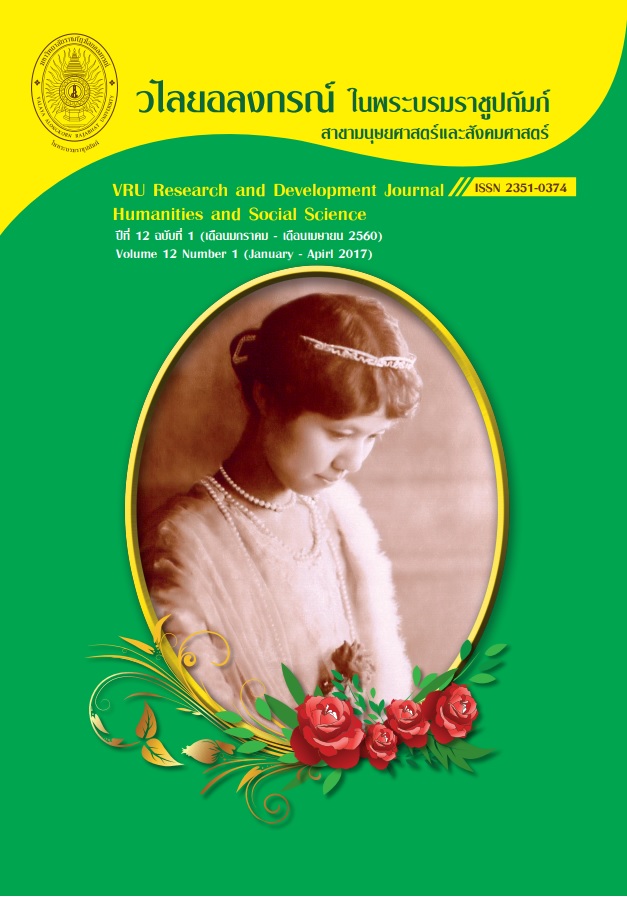อนาคตภาพการอาชีวศึกษาระบบทวิภาคีของสถานศึกษาสังกัดสำนักงาน คณะกรรมการการอาชีวศึกษาในทศวรรษหน้า
Main Article Content
Abstract
การวิจัยครั้งนี้มีวัตถุประสงค์ เพื่อศึกษาอนาคตภาพการอาชีวศึกษาระบบทวิภาคีของสถานศึกษาสังกัดสำนักงานคณะกรรมการการอาชีวศึกษาในทศวรรษหน้า (พ.ศ. 2559-2569) การวิจัยครั้งนี้เป็นการวิจัยแบบผสมผสานด้วยวิธีการวิจัยเชิงปริมาณและเชิงคุณภาพโดยใช้เทคนิคอีดีเอฟอาร์ (Ethnographic Delphi Future Research: EDFR) โดยได้แบ่งการวิจัยเป็น 2 ระยะ ในการวิจัยทั้ง 2 ระยะ ผู้วิจัยใช้การเลือกแบบเจาะจง (Purposive Sampling) เพื่อคัดเลือกกลุ่มตัวอย่างซึ่งเป็นผู้เชี่ยวชาญจำนวน 19 ท่านซึ่งมีความรู้และประสบการณ์เกี่ยวกับการอาชีวศึกษาระบบทวิภาคี การวิจัยระยะแรก เครื่องมือที่ใช้ในการเก็บรวบรวมข้อมูลคือแบบสัมภาษณ์แบบกึ่งโครงสร้าง (Semi-Structure Interviews) และเก็บรวบรวมข้อมูลโดยใช้การวิเคราะห์เนื้อหา สำหรับการวิจัยระยะที่ 2 เครื่องมือในการวิจัยคือแบบสอบถามแบบมาตราส่วนประเมินค่า (Likert's Scale) สถิติที่ใช้ในการวิเคราะห์ข้อมูลประกอบด้วย มัธยฐาน (Median) ฐานนิยม (Mode) ค่าร้อยละ และค่าพิสัยระหว่างควอไทล์ (Interquartile Range)
ผลการวิจัยพบว่า
ผู้เชี่ยวชาญการอาชีวศึกษาระบบทวิภาคีตระหนักว่าแนวโน้มหลักทั้ง 22 ข้อเป็นปัจจัยที่สำคัญต่อการอาชีวศึกษาระบบทวิภาคีในอนาคต การอาชีวศึกษาระบบทวิภาคีของสถานศึกษาสังกัดสำนักงานคณะกรรมการการอาชีวศึกษาได้รับอิทธิพลของกระแสการพัฒนาหลักของโลกที่ก่อให้เกิดการเปลี่ยนแปลงครั้งยิ่งใหญ่ในโลกอนาคต การเปลี่ยนแปลงดังกล่าวได้ส่งผลกระทบต่อประเทศไทยซึ่งเป็นประเทศกำลังพัฒนาทั้งในปัจจุบันและอนาคต โดยประเทศไทยต้องเผชิญสภาวะการแข่งขันด้านต่าง ๆ ท่ามกลางกระแสเศรษฐกิจโลกซึ่งนับวันจะมีการแข่งขันที่รุนแรงขึ้นทุกขณะ การปรับกระบวนทัศน์ของการอาชีวศึกษาระบบทวิภาคีให้สอดรับกับพลวัตรการเปลี่ยนแปลงของแนวโน้มโลกเป็นจุดเปลี่ยนที่สำคัญ ซึ่งสถานศึกษาสังกัดสำนักงานคณะกรรมการการอาชีวศึกษาและผู้เกี่ยวข้องทุกภาคส่วน ต้องร่วมมือกันดำเนินการให้บรรลุแนวโน้มในอนาคตของการอาชีวศึกษาระบบทวิภาคีในทศวรรษหน้า ตามความเห็นของผู้เชี่ยวชาญที่คาดการณ์ไว้ดังนี้
1. ด้านปัจจัยนำเข้า มีแนวโน้มหลักจำนวน 7 ข้อ ได้แก่ 1) นโยบายของรัฐบาล มีแนวโน้มที่เป็นไปได้จำนวน7 ข้อ 2) มาตรฐานคุณวุฒิวิชาชีพมีแนวโน้มที่เป็นไปได้จำนวน 8 ข้อ 3) คุณลักษณะของผู้เรียน มีแนวโน้มที่เป็นไปได้ จำนวน 12 ข้อ 4) งบประมาณและทรัพยากรการผลิตเพื่อใช้ในการจัดการศึกษา มีแนวโน้มที่เป็นไปได้จำนวน 10 ข้อ 5) เป้าหมายในการจัดการศึกษา มีแนวโน้มที่เป็นไปได้จำนวน 9 ข้อ 6) บุคลากร มีแนวโน้มที่เป็นไปได้ จำนวน มีจำนวน 10 ข้อ 7) ความสมดุลระหว่างวัตถุประสงค์ด้านเศรษฐศาสตร์และวัตถุประสงค์ด้านการศึกษา มีแนวโน้มที่เป็นไปได้ จำนวน 6 ข้อ
2. ด้านกระบวนการ มีแนวโน้มหลักจำนวน 14 ข้อ ได้แก่ 1) การจัดการองค์การและระบบบริหารจัดการมีแนวโน้มที่เป็นไปได้จำนวน13 ข้อ 2) การสร้างความร่วมมือในการจัดการศึกษา มีแนวโน้มที่เป็นไปได้ จำนวน 6 ข้อ 3) วิธีการจัดการศึกษาและฝึกอบรม มีแนวโน้มที่เป็นไปได้จำนวน 12 ข้อ 4) ระยะเวลาในการจัดการศึกษาและฝึกอบรม มีแนวโน้มที่เป็นไปได้จำนวน 3 ข้อ 5) ระบบการวัดผลและประเมินผล มีแนวโน้มที่เป็นไปได้จำนวน 8 ข้อ 6) การสร้างข้อตกลงร่วมกันกับผู้มีประโยชน์ร่วมกัน มีแนวโน้มที่เป็นไปได้จำนวน 4 ข้อ 7) การจัดการศึกษาที่มุ่งสู่ความเป็นเลิศ ผู้เชี่ยวชาญมีความเห็นว่า มีแนวโน้มที่เป็นไปได้จำนวน 5 ข้อ 8) การสื่อสารที่ดี มีแนวโน้มที่เป็นไปได้จำนวน 8 ข้อ 9) การบูรณาการการจัดการศึกษาด้านอาชีวศึกษากับการศึกษาสายสามัญศึกษาและอุดมศึกษา มีแนวโน้มที่เป็นไปได้จำนวน 6 ข้อ 10) การจัดการศึกษาให้สอดคล้องกับโลกของงาน มีแนวโน้มที่เป็นไปได้จำนวน 5 ข้อ 11) ความช่วยเหลือในการสร้างผู้ประกอบการใหม่ให้แก่ผู้เรียน มีแนวโน้มที่เป็นไปได้จำนวน 4 ข้อ 12) หลักสูตร มีแนวโน้มที่เป็นไปได้จำนวน 10 ข้อ 13) ภาวะผู้นำ มีแนวโน้มที่เป็นได้จำนวน 7 ข้อ 14) แรงจูงใจ มีแนวโน้มที่เป็นไปได้ จำนวน 17 ข้อ
3. ด้านผลผลิต มีแนวโน้มหลักจำนวน 1 ข้อ ได้แก่ 1) คุณลักษณะของผู้สำเร็จการศึกษา มีแนวโน้มที่เป็นได้จำนวน 6 ข้อ
A Scenario of Dual Vocational Education in the Colleges under the Office of Vocational Education Commission in the Next Decade
The objective of this research was to study a scenario of dual vocational education in the colleges under the Office of Vocational Education Commission in the next decade (2016-2026). In this study, the researcher used EDFR technique which was the mixed methodologies of quantitative research and qualitative research. The sample for both types of research was comprised of 19 dual vocational education specialists, obtained by purposive sampling. The tools used for qualitative data collection was semi-structured interviews. The collected data was analyzed by means of content analysis. In addition, the series of Likert's Scale questionnaire was used as the data collection in the second phase of the research. The statistics used for data analysis were median, mode, percentile and interquartile range.
The results of the study were as follows:
The research findings revealed that every dual vocational specialists realized that dual vocational education in the colleges under the Office of Vocational Education Commission has been affected by world mainstream developments, which have made great changes in the world. Those changes have also affected Thailand, which is a developing country. Amid the world's economic competition, Thailand must encounter more and more serious competitive situations. Shifting the paradigm of dual vocational education to fit the world's trend of dynamic change is the important turning point of the colleges under the Office of Vocational Education. Regarding this matter, all relevant stakeholders should work for together to approach the possible trends for dual vocational education in the next decade approved by the dual vocational education specialists which were comprised of 3 aspects and 175 possible trends, as follows:
1. Input aspect, which was comprised of 1) government policy, in which there were 7 possible trends, 2) professional qualification standards, in which there were 8 possible trends, 3) budget and resources for education management, in which there were 10 possible trends, 4) students' characteristics, in which there were 12 possible trends, 5) objective of education, in which there were 9 possible trends, 6) personnel, in which there were 10 possible trends, and 7) balance of economic purpose and educational purpose, in which there were 6 possible trends.
2. Process aspect, which was comprised of 1) organization management and administration system, in which there were 13 possible trends, 2) education cooperation, in which there were 6 possible trends, 3) methods of education and training, in which there were 12 possible trends, 4) time used in education and training, in which there were 3 possible trends, 5) evaluation system, in which there were 8 trends, 6) mutual agreement between stakeholders, in which there were 4 possible trends, 7) education for excellence, in which there were 5 possible trends, 8) good communication, in which there were 8 possible trends, 9) integration of vocational education, general education and tertiary education, in which there were 6 possible trends, 10) education in congruence with the world of work, in which there were 5 possible trends, 11) assistance in creating of new entrepreneur, in which there were 4 possible trends, 12) curriculum, in which there were 10 trends, 13) leadership, in which there were 7 trends, and 14) motivation, in which there were 17 trends.
3. Output aspect, which was comprised of 1 factor, namely : characteristics of students graduated from vocational colleges, in which there were 6 trends.
Article Details
ลิขสิทธิ์บทความวิจัยที่ได้รับการตีพิมพ์เผยแพร่ในวารสารมนุษยศาสตร์และสังคมศาสตร์ วไลยอลงกรณ์ ในพระบรมราชูปถัมภ์ ถือเป็นกรรมสิทธิ์ของคณะมนุษยศาสตร์และสังคมศาสตร์ มหาวิทยาลัยราชภัฏวไลยอลงกรณ์ ในพระบรมราชูปถัมภ์ ห้ามนำข้อความทั้งหมดหรือบางส่วนไปพิมพ์ซ้ำ เว้นแต่จะได้รับอนุญาตจากมหาวิทยาลัยเป็นลายลักษณ์อักษร
ความรับผิดชอบ เนื้อหาต้นฉบับที่ปรากฏในวารสารมนุษยศาสตร์และสังคมศาสตร์ วไลยอลงกรณ์ ในพระบรมราชูปถัมภ์ เป็นความรับผิดชอบของผู้นิพนธ์บทความหรือผู้เขียนเอง ทั้งนี้ไม่รวมความผิดพลาดอันเกิดจากเทคนิคการพิมพ์
References
กระทรวงศึกษาธิการ. (2554). ข้อเสนอการปฏิรูปการศึกษาในทศวรรษที่ 2 (พ.ศ.2552-2561). กรุงเทพฯ : บริษัท พริกหวานกราฟฟิค จำกัด.
จุมพล พูลภัทรชีวิน. เทคนิคการวิจัยอนาคตแบบ EDFR. วิจัยการศึกษา ปีที่ 10 ฉบับที่ 5 (มิ.ย.–ก.ค. 2530). [ฉบับปรับปรุง 2548]
. (2553). แนวทางการพัฒนาการอาชีวศึกษาและเทคโนโลยีของประเทศไทยในทศวรรษหน้า. วารสารวิชาการครุศาสตร์อุตสาหกรรม มหาวิทยาลัยเทคโนโลยีพระจอมเกล้าพระนครเหนือ 1(1). 95-100
สำนักงานคณะกรรมการพัฒนาการเศรษฐกิจและสังคมแห่งชาติ. (2548). ยุทธศาสตร์การพัฒนาทรัพยากรมนุษย์เพื่อเพิ่มขีดความสามารถในการแข่งขันของอุตสาหกรรมหลัก. กรุงเทพ ฯ : บริษัท เพชรรุ่งการพิมพ์ จำกัด.
สำนักงานเลขาธิการสภาการศึกษา. (2550). รายงานวิกฤติการศึกษาไทย. กรุงเทพ ฯ : ม.ป.พ.
Asian Development Bank. (2005). Improving Technical Education and Vocational Training Strategies for Asia. n.p.
. (2008). Indonesia: Vocational Education Strengthening Project. n.p.
. (2009). A Good Practice in Technical and Vocational Education and Training. Manila : n.p.
Barber, Michael & Mourshed, Mona. (2009). Shaping the Future : How Good Education Systems Can Become Great in Decade Ahead. McKinsey and company.
. (2002). New Directions for Community College. John Wiley & Sons Inc.
Lunenburg , Fred C. and Ornstien, Allen C. (2008). Educational Administration, (Concept and Practice), 5th ed. Belmont, USA: Wadsworth, Cengage Learning,
Macmillan, Thomas T. (1971, May). The Delphi Technique. Paper Presented at the annual meeting of the California Junior Colleges Associations Committee on Research and Development, Monterey, California , 3-5.


